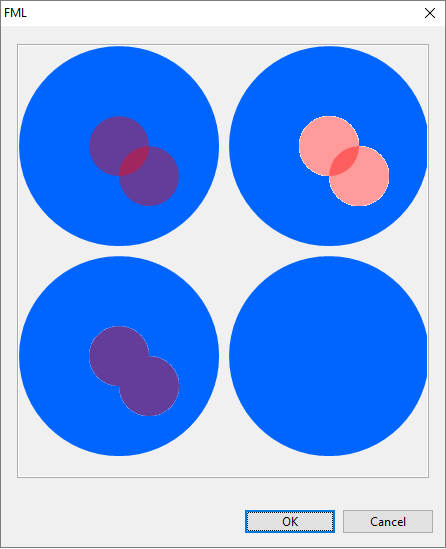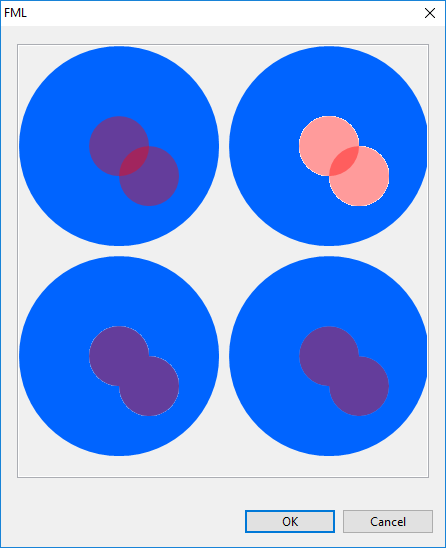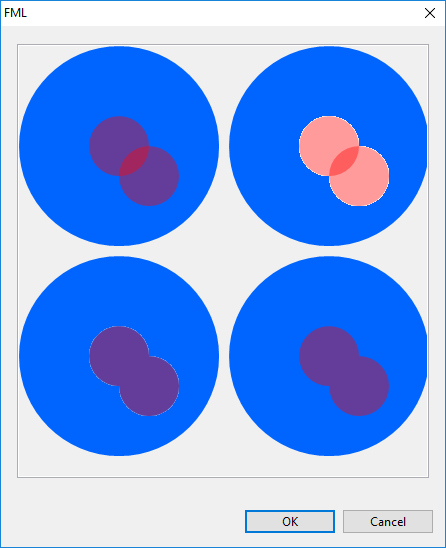I'm attempting to draw a transparent mask of combined shapes over the top of an already in place image. I have provided an example of the techniques I'm trying via the dialog code included in this post. Here's a screenshot of what it produces.
Example 1 (top left) highlights the problem I want to solve, I wish to have the 2 circles Or any intersecting shapes/arcs, all draw together with the same level of alpha, ie without the compounding opaqueness caused by drawing over the top of each other.
Example 3 (bottom left) is my attempt to resolve the issue by creating a separate image with solid shapes on, then making that entire image transparent, what happens i think is that using this technique makes an image where the White is treated as the transparent colour, so the edge of the circle is blended with white so that when you draw it on it causes a "halo" effect around the shape.
Example 2 (top left) highlights this issue further by drawing the circles in the image as transparent too, so you can see the more pink colour caused by the highlight.
My question is, without any knowledge of the background colour, and without turning anti-aliasing off, how can I achieve the effect I am trying for? Is there a way, because all my research is coming up blank? Maybe I need to use a different image drawing solution and port back to SWT? I know it's capable of drawing Transparent images if loaded directly from a file so I know it can hold this sort of data, but how do I create it?
import org.eclipse.jface.dialogs.Dialog;
import org.eclipse.swt.SWT;
import org.eclipse.swt.events.PaintEvent;
import org.eclipse.swt.events.PaintListener;
import org.eclipse.swt.graphics.Color;
import org.eclipse.swt.graphics.GC;
import org.eclipse.swt.graphics.Image;
import org.eclipse.swt.graphics.ImageData;
import org.eclipse.swt.graphics.Point;
import org.eclipse.swt.graphics.RGB;
import org.eclipse.swt.layout.GridData;
import org.eclipse.swt.layout.GridLayout;
import org.eclipse.swt.widgets.Canvas;
import org.eclipse.swt.widgets.Composite;
import org.eclipse.swt.widgets.Control;
import org.eclipse.swt.widgets.Display;
import org.eclipse.swt.widgets.Shell;
public class FMLDialog extends Dialog
{
private Color red;
private Color blue;
public FMLDialog(Shell parentShell)
{
super(parentShell);
}
@Override
protected void configureShell(Shell shell)
{
red = new Color(shell.getDisplay(), new RGB(255,0,0));
blue = new Color(shell.getDisplay(), new RGB(0,100,255));
super.configureShell(shell);
shell.setSize(new Point(450,550));
shell.setText("FML");
}
@Override
public Control createDialogArea(final Composite comp)
{
Composite content = (Composite) super.createDialogArea(comp);
Composite parent = new Composite(content, SWT.NONE);
GridLayout gridLayout2 = new GridLayout(1, false);
parent.setLayout(gridLayout2);
parent.setLayoutData(new GridData(SWT.FILL, SWT.FILL, true, true));
final Canvas c = new Canvas(parent, SWT.BORDER);
c.setLayoutData(new GridData(SWT.FILL, SWT.FILL, true, true));
c.addPaintListener(new PaintListener() {
@Override
public void paintControl(PaintEvent e) {
e.gc.setAntialias(SWT.ON);
drawFirstLayer(e.gc, 0, 0);
drawFirstLayer(e.gc, 210, 0);
drawFirstLayer(e.gc, 210, 210);
drawFirstLayer(e.gc, 0, 210);
drawSecondLayerTake1(e.gc, 0, 0);
drawSecondLayerTake2(e.gc, 210, 0);
drawSecondLayerTake3(e.gc, 0, 210);
drawSecondLayerTake4(e.gc, 210, 210);
}
});
return content;
}
private void drawFirstLayer(GC gc, int x, int y) {
gc.setBackground(blue);
gc.fillOval(x, y, 200 , 200);
}
private void drawSecondLayerTake1(GC gc, int x, int y) {
// Simply draw 2 transparent circles
// Issue here is the overlap between circles where the Alpha layers up
gc.setAlpha(100);
gc.setBackground(red);
gc.fillOval(x + 70, y + 70, 60 , 60);
gc.fillOval(x + 100, y + 100, 60 , 60);
gc.setAlpha(255);
}
private void drawSecondLayerTake2(GC gc, int x, int y) {
// Create an image with 2 transparent circles
// Issue here is the overlap between circles where the Alpha layers up from the first
// PLUS becasue my transparent colour is fixed to white the alpa on the circles is blended in to the white
final Image src = new Image(null, 300, 300);
final ImageData imageData = src.getImageData();
imageData.transparentPixel = imageData.getPixel(0, 0);
src.dispose();
final Image processedImage = new Image(Display.getCurrent(), imageData);
final GC imageGC = new GC(processedImage);
imageGC.setAntialias(SWT.ON);
imageGC.setAlpha(100);
imageGC.setBackground(red);
imageGC.fillOval(70, 70, 60 , 60);
imageGC.fillOval(100, 100, 60 , 60);
imageGC.dispose();
gc.drawImage(processedImage, x + 0, y + 0);
}
private void drawSecondLayerTake3(GC gc, int x, int y) {
// Create an image with 2 solid circles, then draw that image on to the canvas with Alpha values.
// Overlap issue goes away because the whole image is being made transparent together HOWEVER
// there is a Halo effect around the edge of the red where the original circles were antialiased to blend into the "white"
// background.
final Image src = new Image(null, 300, 300);
final ImageData imageData = src.getImageData();
imageData.transparentPixel = imageData.getPixel(0, 0);
src.dispose();
final Image processedImage = new Image(Display.getCurrent(), imageData);
final GC imageGC = new GC(processedImage);
imageGC.setAntialias(SWT.ON);
imageGC.setBackground(red);
imageGC.fillOval(70, 70, 60 , 60);
imageGC.fillOval(100, 100, 60 , 60);
imageGC.dispose();
gc.setAlpha(100);
gc.drawImage(processedImage, x + 0, y + 0);
}
private void drawSecondLayerTake4(GC gc, int x, int y) {
// I need this one to draw like take 3 but without the white "halo" effect on the edge
// How?!
}
public static void main(String[] args) {
Display d = new Display();
Shell s = new Shell();
FMLDialog fml = new FMLDialog(s);
fml.open();
}
}



